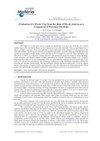优化电动处理增强砂浆耐久性:离子迁移和微观结构分析
IF 1.2
4区 材料科学
Q4 MATERIALS SCIENCE, MULTIDISCIPLINARY
引用次数: 0
摘要
本研究利用一系列实验技术研究了电动处理对砂浆试样的影响。离子迁移测试表明,电压和持续时间的增加导致电荷转移的增加,其中Ca(OH)2电解质显示出最高的阳离子迁移。x射线荧光分析表明,纳米二氧化硅处理导致氧化物含量最高,有效转化吸收元素。氯离子渗透试验表明,Ca(OH)2处理的电荷通过量最小,表明氯离子渗透量最小,而NaOH和KOH处理的电荷通过量较大。场发射扫描电镜分析提供了结构变化和材料沉积的视觉证据。氢氧化钙处理降低了孔隙率,氢氧化钠和氢氧化钾处理显示出明显的颗粒分布,纳米二氧化硅处理导致了毛发状晶体结构的形成。这些发现有助于了解不同处理后水泥砂浆试件的微观结构和组成。纳米二氧化硅电解质似乎是电动治疗的可行选择,而Ca(OH)2处理表明了减少砂浆样品中氯化物渗透的潜力。结果为优化电动处理以改善砂浆性能提供了见解。本文章由计算机程序翻译,如有差异,请以英文原文为准。
Optimizing electrokinetic treatments for enhanced mortar durability: ionic migration and microstructural analysis
This study investigated the effects of electrokinetic treatments on mortar specimens using a range of experimental techniques. Ionic migration tests revealed that increasing voltage and duration led to higher charge transfer, with Ca(OH)2 electrolyte showing the highest cationic migration. X-ray fluorescence analysis indicated that Nano-Silica treatment resulted in the highest oxide content, transforming absorbed elements effectively. The chloride penetration test demonstrated that Ca(OH)2 treatment exhibited the lowest charge passed, suggesting minimal chloride penetration, while NaOH and KOH treatments showed higher charge passed. Field Emission Scanning Electron Microscopy analysis provided visual evidence of structural changes and material depositions. Calcium Hydroxide treatment reduced porosity, Sodium Hydroxide, and Potassium Hydroxide treatments displayed distinct particle distributions, and Nano Silica treatment led to the formation of hair-like crystal structures. These findings help to understand the microstructure and composition of cement mortar specimens after various treatments. The nano-silica electrolyte appeared as a viable choice for electro-kinetic therapy, whereas Ca(OH)2 treatment stated the potential to reduce chloride penetration in mortar specimens. The results offer insights into optimizing electrokinetic treatments for improved mortar performance.
求助全文
通过发布文献求助,成功后即可免费获取论文全文。
去求助
来源期刊

Materia-rio De Janeiro
MATERIALS SCIENCE, MULTIDISCIPLINARY-
CiteScore
1.00
自引率
25.00%
发文量
51
审稿时长
6 weeks
期刊介绍:
All the articles are submitted to a careful peer-reviewing evaluation process by the journal''s Editorial Board. The Editorial Board, reviewers and authors make use of a web based proprietary automated tool to deal with the reviewing procedures.the Revista Matéria''s article reviewing restricted access system - SEER. Authors are not informed about the identity of the reviewers.
 求助内容:
求助内容: 应助结果提醒方式:
应助结果提醒方式:


